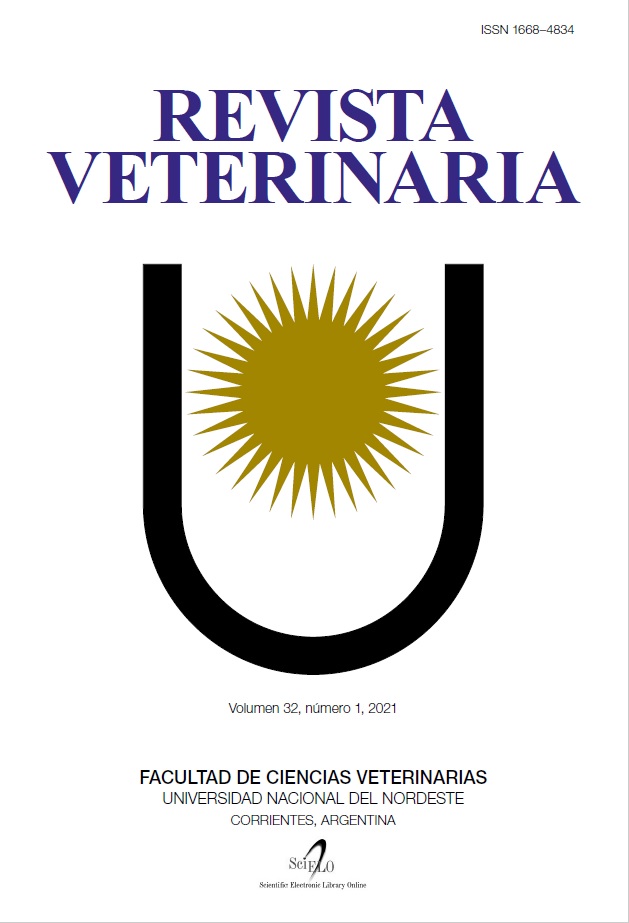Chemical characteristics of buffalo meat in a self-consumption feeding system in Corrientes, Argentina
DOI:
https://doi.org/10.30972/vet.3215635Keywords:
buffaloes, meat, quality, self-consumption, fatty acidsAbstract
The exploitation of buffaloes is presented as an alternative for meat production in the northeast region of Argentina, as it adapts to special agroecological conditions due to the flooding of the land, the presence of low digestible pastures and ectoparasites in which cattle are not always expresses its maximum potentiality. In order to study the quality of post-weaning buffaloes meat from 12 to 15 months of age and with an average weight of 380 kg, the composition of the feed supplied by self-consumption system was studied as a strategic supplementation to achieve the slaughter weight and chemical composition of meat, as well as of the fatty acids present in intramuscular fat by gas chromatography. The meat values found were 28.09% DM, 71.91% humidity, 23.69% CP, 1.94% EE and 1.23% ash. With regard to fatty acids, values of 18.59% saturated and 81.4% unsaturated were found, among the latter being 77.34% monounsaturated and 4% polyunsaturated, concluding that buffalo meat is nutritionally healthy and productively profitable for the region.
Downloads
References
Andrighetto C et al. 2008. Características fisico-químicas e sensoriais da carne de bubalinos Murrah abatidos em diferentes períodos de confinamento. Rev Bras Zootec 37: 12, 2179-2184.
Association of Official Analytical Chemist (AOAC). 1990. Official Methods of Analysis, https://law.resource. org/pub/us/cfr/ibr/002/aoac.methods.1.199.
Arias MA. 2007. Panorama general de la ganadería en los diferentes ambientes del NEA; 1er Seminario de Ganadería del NEA. Amanecer Rural, Resistencia, Chaco, p. 5-11.
Diluccia A et al. 2003. Effect of dietary energy content on the intramuscular fat depots and triglyceride composition of river buffalo meat. Meat Science 65: 1379-1389.
Folch JM, Lees M, Stanley SG. 1957. A simple method for the isolation and purification of total lipids from animal tissues. Journal Biol Chem 226: 497-509.
Jorge AM et al. 2005. Características quantitativas da carcaça de bubalinos de três grupos genéticos terminados em confinamento e abatidos em diferentes estádios de maturidade. Rev Bras Zootec 34: 6, 2376-2381.
Kandeepan G et al. 2009. Effect of age and gender on the processing characteristics of buffalo meat. Meat Sci 83: 10-14.
http://www.magyp.gob.ar/sitio/areas/bovinos/informacion_
sectorial/archivos//000030.Indicadores/000001-%20Indicadores%20bovinos%20mensuales.pdf
Mendoza MG et al. 2005. Occurrence of conjugated linoleic acid in longissimus dorsi muscle of water buffalo (Bubalus bubalis) and zebu-type cattle raised under savannah conditions. Meat Science 69: 93-100.
Neath KE et al. 2007. Difference in tenderness and pH decline between water buffalo meat and beef during postmortem aging. Meat Sci 75: 499-505.
Rodriguez VC, Bressan MA, Cardoso MG, Defreitas RT. 2004. Ácidos graxos na carne de búfalos e bovinos castrados e inteiros. Rev Bras Zoot 33: 2, 434-443.
Santos SJ, Mendes IA, Portugal PV, Bessa RJ. 2004. Effect of particle size and soybean oil supplementation on growth performance, carcass and meat quality and fatty acid composition of intramuscular lipids of lambs. Livestock Prod Sci 90: 79-88.
Zava, M. 2011. El búfalo doméstico, p.6. Ed. Orientación Gráfica. INTA.
Downloads
Published
How to Cite
Issue
Section
License
Revista Veterinaria (Rev. Vet.) maintains a commitment to the policies of Open Access to scientific information, as it considers that both scientific publications as well as research investigations funded by public resources should circulate freely without restrictions. Revista Veterinaria (Rev. Vet.) ratifies the Open Access model in which scientific publications are made freely available at no cost online.











.jpg)
.jpg)



